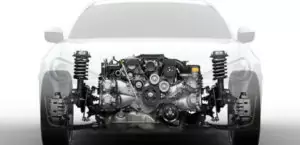The 2.0-liter Nissan KR20DDET (or KR20 for short) or 2.0 VC-Turbo engine has been produced in Japan since 2017 and is used in Altima sedans, but is best known for the Infiniti QX50, QX55 and QX60 crossovers. Such a power unit is distinguished by the presence of a proprietary compression ratio adjustment system.
The KR family also includes an internal combustion engine: KR15DDT.
The engine was installed on:
- Infiniti QX50 2 (P71) in 2017 – …;
- Infiniti QX55 1 (J55) in 2021 – …;
- Infiniti QX60 2 (L51) in 2021 – …;
- Nissan Altima 6 (L34) in 2018 – …
Specifications
| Production years | 2017-… |
| Displacement, cc | 1970 – 1997 |
| Fuel system | combined injection |
| Power output, hp | 250 – 272 |
| Torque output, Nm | 380 |
| Cylinder block | aluminum R4 |
| Block head | aluminum 16v |
| Cylinder bore, mm | 84 |
| Piston stroke, mm | 88.9 – 90.1 |
| Compression ratio | 8.0 – 14.0 |
| Features | ATR |
| Hydraulic lifters | no |
| Timing drive | chain |
| Phase regulator | on both shafts |
| Turbocharging | Garrett MGT2056Z |
| Recommended engine oil | 5W-30 |
| Engine oil capacity, liter | 4.7 |
| Fuel type | petrol |
| Euro standards | EURO 6 |
| Fuel consumption, L/100 km (for Infiniti QX50 2020) — city — highway — combined |
10.5 7.6 8.6 |
| Engine lifespan, km | ~220 000 |
| Weight, kg | 137 |
Disadvantages of the KR20DDET engine
- This turbo engine was produced not so long ago that statistics of its breakdowns were collected;
- On specialized forums, they regularly complain only about glitches of the Start-Stop system;
- The combined injection system relieves the engine of deposits on the intake valves;
- It is necessary to adjust the valve clearances every 100,000 km, there are no hydraulic lifters;
- The main problem of the engine is where to fix the compression ratio system.






